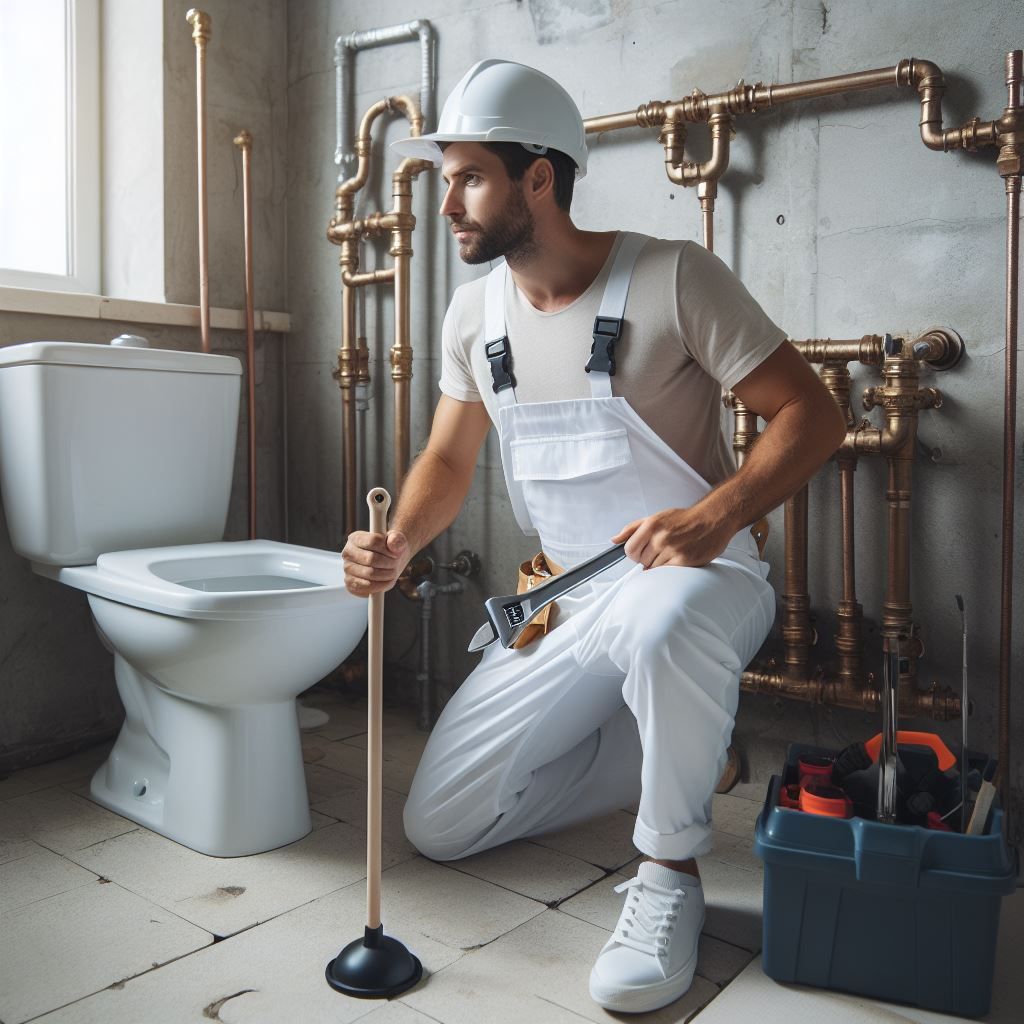Introduction
Green plumbing is a vital aspect of eco-friendly practices in Canada.
With the increasing need for sustainability and reducing environmental impacts, green plumbing plays a significant role in achieving these goals.
Canada has taken a proactive approach towards eco-friendly practices, making it a leader in the field.
Canada’s commitment to eco-friendly practices is evident in various ways.
The government is actively investing in research and development of green plumbing technologies.
Additionally, policies and regulations are in place to promote the use of sustainable plumbing materials and techniques.
The adoption of eco-friendly plumbing practices in Canada has numerous benefits.
Firstly, it helps in conserving water by efficiently managing water usage through technologies like low-flow fixtures and rainwater harvesting systems.
This reduces strain on the water supply and helps lower utility bills.
Secondly, green plumbing promotes energy efficiency by utilizing technologies like high-efficiency water heaters and insulating pipes.
This significantly reduces energy consumption and, in turn, decreases greenhouse gas emissions.
Moreover, Canada’s focus on eco-friendly plumbing practices has a positive impact on indoor air quality.
By using low VOC (volatile organic compound) plumbing materials, the release of harmful chemicals is minimized, ensuring a healthier living environment for residents.
In short, Canada’s eco-friendly plumbing practices are essential for creating a sustainable future.
Through the adoption of green plumbing technologies and materials, Canada is leading the way in reducing water and energy waste, conserving resources, and improving overall sustainability.
Overview of Green Plumbing
Define green plumbing and its key principles
- Green plumbing refers to sustainable and environmentally friendly practices in the plumbing industry.
- The key principles include water conservation, energy efficiency, and use of recycled materials.
- It aims to minimize the negative impact of plumbing systems on the environment.
- By implementing green plumbing, we can reduce water waste and energy consumption.
- It promotes the use of renewable resources and promotes a healthier living environment.
- Overall, green plumbing strives to create a balance between human needs and environmental preservation.
The significance of adopting eco-friendly practices in the plumbing industry
- Adopting eco-friendly practices in the plumbing industry is crucial for sustainable development.
- Traditional plumbing methods often waste water, energy, and contribute to pollution.
- By going green, we can address these issues and create a more sustainable future.
- Eco-friendly practices in plumbing help in conserving our precious natural resources.
- It reduces the strain on water sources and promotes responsible use.
- Furthermore, it helps in reducing greenhouse gas emissions, thus mitigating climate change.
- By adopting green plumbing practices, we can lead the way towards a more sustainable future.
The benefits of green plumbing for both the environment and homeowners
- Green plumbing significantly reduces water consumption through efficient fixtures and water-saving technologies.
- This reduction in water usage helps in conserving water resources and protects aquatic ecosystems.
- It also leads to a substantial decrease in energy consumption, resulting in lower utility bills for homeowners.
- Furthermore, green plumbing reduces the carbon footprint associated with water and energy usage.
- By conserving water and energy, homeowners can contribute to reducing overall environmental impact.
- Green plumbing utilizes sustainable materials, such as recycled pipes and fittings, reducing waste.
- These eco-friendly materials are also healthier for residents, as they minimize exposure to harmful chemicals.
- In addition, green plumbing reduces the risk of waterborne diseases and improves indoor air quality.
- For homeowners, green plumbing increases the value of their property and helps in saving money in the long run.
- By implementing green plumbing practices, they can enjoy a more sustainable, efficient, and comfortable home.
In fact, green plumbing offers significant environmental and homeowner benefits. It allows us to conserve water, energy, and reduce pollution.
By adopting eco-friendly practices in the plumbing industry, we can create a more sustainable future while enjoying long-term cost savings and improved living conditions.
Embracing green plumbing principles is a win-win situation for both the environment and homeowners alike.
Read: Latest Plumbing Trends in the Canadian Market
Canadian Plumbing Standards and Regulations
Importance of Regulations to Ensure Eco-Friendly Practices
- Regulations play a crucial role in maintaining eco-friendly practices in Canada’s plumbing industry.
- They help prevent harmful environmental impacts by setting guidelines for sustainable plumbing installations.
- Regulations ensure that plumbing professionals adhere to specific standards, reducing water waste and promoting energy efficiency.
- By enforcing eco-friendly practices, regulations safeguard Canada’s natural resources for future generations.
Overview of Canadian Plumbing Standards
- The Canadian Plumbing Code (CPC) is the primary authority for plumbing standards in Canada.
- Developed by the Canadian Commission on Building and Fire Codes, the CPC establishes minimum requirements for plumbing systems.
- It covers various aspects, including pipe materials, installation methods, fixtures, backflow prevention, and drainage systems.
- The CPC ensures that plumbing systems are safe, functional, and designed to minimize environmental impact.
Specific Requirements for Green Plumbing Installations and Certifications
- Green plumbing installations aim to reduce water consumption and promote sustainability.
- Plumbers must follow specific regulations to ensure the use of eco-friendly materials, such as low-flow fixtures and water-efficient appliances.
- Certifications, like LEED (Leadership in Energy and Environmental Design) and WaterSense, validate eco-friendly plumbing practices.
- LEED certification recognizes buildings that meet high environmental standards, including efficient plumbing systems.
- WaterSense certification identifies products that meet water efficiency and performance criteria set by the U.S. Environmental Protection Agency (EPA).
- Both certifications encourage the adoption of green plumbing practices by offering incentives and recognition to compliant projects.
In essence, regulations in Canada’s plumbing industry are essential in ensuring eco-friendly practices.
They contribute to sustainable development by reducing water waste and promoting energy efficiency.
The Canadian Plumbing Code serves as the guiding standard for plumbing installations, guaranteeing safety and functionality while minimizing environmental impact.
To address eco-friendliness, specific requirements for green plumbing installations and certifications, such as LEED and WaterSense, encourage the adoption of environmentally conscious practices within the industry.
Through strict adherence to these regulations, Canada continues to prioritize sustainability and protect its valuable natural resources.
Read: Safety Tips for Plumbers: A Canadian Perspective
Unlock Your Career Potential
Visualize a clear path to success with our tailored Career Consulting service. Personalized insights in just 1-3 days.
Get StartedWater Conservation Practices
The importance of water conservation in the context of plumbing
Water conservation is crucial in plumbing as it helps address the growing water scarcity issue and reduces environmental impact.
Canada’s water conservation efforts and initiatives
Canada has implemented various water conservation programs, including public awareness campaigns, water-efficient building codes, and rebate programs.
- Canada’s WaterSense program promotes the use of water-efficient products and practices.
- The Great Lakes Protection Act ensures the sustainable use and conservation of this important water resource.
- The Water Smart Buildings program encourages retrofitting and designing water-efficient structures.
These initiatives highlight Canada’s commitment to conserving water resources for future generations.
Specific eco-friendly plumbing fixtures and technologies used in Canada, such as low-flow toilets and faucets
Canadian plumbing industry has embraced eco-friendly fixtures and technologies that significantly reduce water consumption without compromising performance.
- Low-flow toilets are designed to use less water per flush compared to conventional toilets.
- WaterSense certified faucets and showerheads reduce water flow while maintaining a satisfying user experience.
- Smart irrigation systems utilize sensors and weather data to optimize outdoor water usage.
- Dual-flush toilets allow users to choose between low and high water flushes according to their needs.
These fixtures and technologies play a crucial role in conserving water and minimizing wastage.
The Canadian government encourages the adoption of such eco-friendly practices and offers incentives to promote their installation.
- Rebate programs are available to homeowners who upgrade their plumbing fixtures to water-efficient alternatives.
- Building codes require new constructions and renovations to incorporate water-saving measures.
These measures ensure that water conservation becomes an integral part of plumbing practices in Canada.
Furthermore, the plumbing industry has also taken initiatives to educate homeowners and professionals about water conservation.
- Plumbing associations conduct workshops and training programs on eco-friendly plumbing practices.
- Homeowners are provided with guidance on water-efficient plumbing fixtures during remodeling or construction.
By promoting awareness and providing necessary resources, Canada aims to enhance its water conservation efforts.
Water conservation practices in plumbing are vital to address water scarcity and protect the environment.
Canada, through its impactful initiatives and programs, has shown a strong commitment to water conservation.
Utilizing eco-friendly plumbing fixtures and technologies, such as low-flow toilets and faucets, contributes significantly to water reduction.
With continued efforts and awareness, Canada’s plumbing industry can further enhance water conservation practices and create a sustainable future for all.
Read: Apprenticeship in Plumbing: A Canadian Overview

Energy-Efficient Plumbing Systems
The role of energy-efficient plumbing in reducing carbon emissions
Energy-efficient plumbing stands as a formidable ally in the battle against climate change.
By exploring its role in curbing carbon emissions, we uncover the transformative potential within our pipes and fixtures.
The integration of green technologies and practices paves the way for a future where plumbing is not just a service but a sustainability frontier.
As the world grapples with environmental challenges, Canada stands at the forefront of progressive plumbing solutions.
Canada’s focus on energy-efficient plumbing practices, such as using solar water heaters and heat recovery systems
- Solar Water Heaters: In the realm of water heating, Canada’s commitment to eco-friendly practices shines through the adoption of solar water heaters. These innovative systems harness the power of the sun, providing homes with a sustainable and cost-effective alternative.
- Heat Recovery Systems: Another cornerstone of Canada’s green plumbing practices is the incorporation of heat recovery systems. These systems capture and reuse energy that would otherwise be lost, further reducing the environmental impact of traditional plumbing.
The benefits of energy-efficient plumbing in terms of cost savings and environmental impact
- Cost Savings: Homeowners embracing energy-efficient plumbing not only contribute to a greener planet but also witness tangible benefits in their wallets. Reduced utility bills become a reality as energy-efficient systems optimize resource usage.
- Environmental Impact: The ripple effects of energy-efficient plumbing extend beyond personal savings. Every drop of water conserved and each unit of energy saved contributes to a healthier environment. This dual impact positions eco-friendly plumbing as a crucial player in sustainable living.
In general, energy-efficient plumbing systems play a vital role in reducing carbon emissions and promoting sustainable practices.
Canada’s focus on incorporating energy-efficient plumbing techniques, such as solar water heaters and heat recovery systems, showcases its commitment to environmental conservation.
These practices offer numerous benefits, including cost savings for homeowners, decreased reliance on fossil fuels, and reduced greenhouse gas emissions.
By embracing energy-efficient plumbing, Canada can enhance its energy resilience while contributing to a greener future.
Read: Plumbing Codes in Canada: What You Should Know
Green Plumbing Training and Education
Importance of providing training and education on green plumbing practices
Providing training and education on green plumbing practices is of utmost importance.
Plumbers need continuous learning to stay updated with the latest eco-friendly techniques.
This training helps them understand the environmental impact of their work and empowers them to minimize water consumption, reduce energy waste, and promote sustainability in plumbing systems.
Canada’s initiatives to promote green plumbing education among professionals
To encourage professionals to adopt green plumbing practices, Canada has taken several initiatives.
These initiatives include funding programs that provide training and education in sustainable plumbing.
By collaborating with industry associations, government agencies offer workshops and seminars focused on green plumbing.
Such initiatives create a supportive environment for professionals to learn, exchange ideas, and build networks to advance green plumbing practices in the country.
Availability of certifications and specialized courses in sustainable plumbing practices
Professionals who wish to specialize in sustainable plumbing can pursue certifications like LEED certification.
Recognized in Canada, LEED certification acknowledges their expertise in designing and implementing eco-friendly plumbing systems.
Additionally, vocational schools and training institutions offer specialized courses on green plumbing.
These courses cover topics such as rainwater harvesting, graywater recycling, and energy-efficient plumbing fixtures.
Completion of these courses allows plumbers to showcase their commitment to sustainable practices.
In brief, the availability of training, education, and certifications plays a crucial role in promoting green plumbing practices in Canada.
Professionals who undergo these initiatives gain the necessary knowledge and skills to provide efficient, eco-friendly solutions.
With continuous learning and specialized courses, plumbers contribute to the overall effort of protecting natural resources and building a sustainable future.
Case Studies: Canadian Eco-Friendly Plumbing Projects
Notable Examples of Eco-Friendly Plumbing Projects in Canada
- The False Creek Neighbourhood Energy Utility project in Vancouver, which provides low-carbon heating and cooling to multiple buildings.
- The Rainwater Harvesting System in Toronto, where rainwater is collected and reused for flushing toilets and irrigating landscapes.
- The Okanagan College Trades Renewal project in British Columbia, which incorporates water-efficient fixtures and rainwater harvesting systems.
Innovative Technologies and Practices Implemented in these Projects
- Installation of high-efficiency toilets, faucets, and showerheads to reduce water usage.
- Utilization of graywater systems for recycling water from sinks, showers, and laundry for irrigation.
- Implementation of geothermal heat pumps to provide energy-efficient heating and cooling.
- Incorporation of solar thermal systems to heat water using renewable energy sources.
Positive Impact and Results Achieved Through These Green Plumbing Initiatives
- Significant reduction in water consumption, leading to water conservation and reduced strain on water resources.
- Decreased energy consumption and greenhouse gas emissions, resulting in a cleaner and healthier environment.
- Cost savings for building owners and residents due to lower water and energy bills.
- Improved indoor air quality and overall comfort in buildings through the use of advanced ventilation systems.
- Enhanced reputation for eco-friendly and socially responsible practices for companies and institutions.
- Increased community awareness and education about sustainable plumbing practices for a greener future.
The mentioned case studies highlight Canada’s commitment to eco-friendly plumbing practices, showcasing innovative technologies and their positive impact on the environment.
These notable examples serve as inspiration and encouragement for future green plumbing initiatives.
Conclusion
To summarize, this blog post highlighted Canada’s eco-friendly plumbing practices, focusing on the importance of green plumbing.
Green plumbing plays a vital role in Canada’s sustainable development by conserving water, reducing energy consumption, and minimizing environmental impact.
It is crucial for readers to adopt eco-friendly plumbing practices in their own homes or businesses to contribute to a greener future.
Start by installing low-flow fixtures, using water-efficient appliances, and practicing proper waste management.
Embracing green plumbing not only benefits the environment but also saves money on water and energy bills. Make the switch today and be part of the solution.




